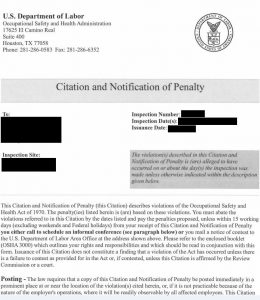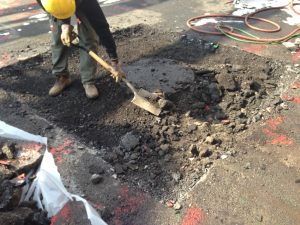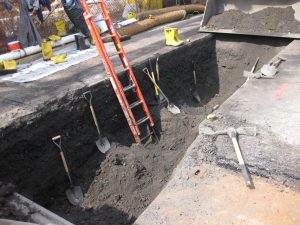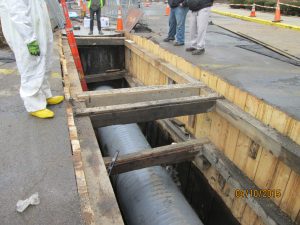Many construction site supervisors are concerned about  the safety and worry that they are leaving themselves open to potential hazards which can result in the serious injury of an employee and heavy fines from regulatory agencies.
the safety and worry that they are leaving themselves open to potential hazards which can result in the serious injury of an employee and heavy fines from regulatory agencies.
The importance of Environmental Health and Safety (EHS) in the construction industry cannot be overstated. At Walden, we pride ourselves in our record of safety during construction projects. Our staff includes Certified Safety Professionals (CSPs) and Associate Safety Professionals (ASPs) that understand Occupational Safety and Health Administration (OSHA) regulations and can audit your site for non-compliance. Excavating and trenching activities are some of the most dangerous and misunderstood construction activities.
Everyone in the construction industry has worked on a job where there was some excavation work. Although excavation is a common construction practice, many don’t understand what rules govern excavating and the protections required.
Definition and Governance
The OSHA defines an excavation as “any man-made cut, cavity, trench, or depression in an earth surface, formed by earth removal.” By this definition, any disturbance to the surface (asphalt, concrete, grass, soil, etc.) is considered an excavation and the site must follow proper excavation safety regulations. OSHA governs the general industry under 29 CFR 1910 Subpart D and H and the construction industry is governed by 29 CFR 1926 Subpart P.
 Know Before You Dig
Know Before You Dig
Before excavation work can begin, the excavation area shall be cleared of all obstructions. All underground concerns such as utilities shall be located prior to excavation work to prevent damage to the utilities and danger or harm to employees. Some regions require employers to call the local utility companies prior to excavation work to allow the company time to mark their utilities so they can be avoided during excavation work.
Visibility Requirements
Employees working within or around the excavation shall be protected from vehicular traffic. All employees should wear reflective vests as protection from vehicular traffic. Additionally, the excavations shall be protected from vehicles using methods such as cones, fencing, concrete blocks, etc.
Safety Requirements for Entrances and Exits
Once the excavation has been started, a means of egress (entrance/exit) into and out of the excavation and/or trench is required. A ramp or runway can be installed for employee and equipment to enter and exit the excavation, but often require design by a “competent person”. A “competent person” means someone who is able to identify hazards in the work area which are dangerous to employees and has the authority to implement measures to remove the hazards. Once the excavation or trench is four (4) feet deep or greater, a ladder, stairway, or ramp is required no less than every 25 lateral feet.
Struck-By Hazards
Employees shall not stand underneath lifting or digging equipment to protect from falling loads. Employees shall also be protected from falling loose rock or soil. All materials and equipment shall be kept a minimum of two (2) feet from the excavation edge to prevent any material from falling or rolling into the excavation. When equipment is operating adjacent to the excavation, and when the operator cannot clearly see the edge of the excavation, an employee shall watch and warn operator of the edge or a warning system shall be utilized.
Breathing Hazards
In any excavation where a hazardous atmosphere could exist, the atmosphere must be checked and confirmed safe prior to any employee entering the excavation. Additionally, in any area where there is a reasonable expectation of a hazardous atmosphere, there shall be emergency rescue equipment available (e.g. safety harness and line, basket stretcher, breathing apparatus, etc.). Walden Site Safety Officers can monitor breathing environments on-site to grant work approval.
All excavations and trenches should be inspected daily, including the adjacent areas and protection systems. The inspection should be completed by a “competent person” to prevent cave-ins and look for indications of protection systems failure, potential for hazardous atmosphere, and evidence of other dangerous/hazardous conditions.
Further Excavations Requirements
The excavation must be free of water while employees are within the excavation and cannot compromise appurtenant structures. Additional requirements for protection and support systems are triggered once excavations are five (5) feet deep or greater, as discussed in our next blog, “Construction Site Safety Concern: Trenches and Excavations Part II”.
Walden Expertise
Walden has worked extensively in the construction industry for over 22 years. Walden is well versed in excavation and trenching safety requirements and has multiple trained “competent people” who can help your project stay in compliance with OSHA regulations. If you want additional information on excavation rules or regulations or have questions on how Walden can help your project stay in compliance, please call us at (516) 624-7200. Make sure to check out our other Environmental Health and Safety capabilities.

